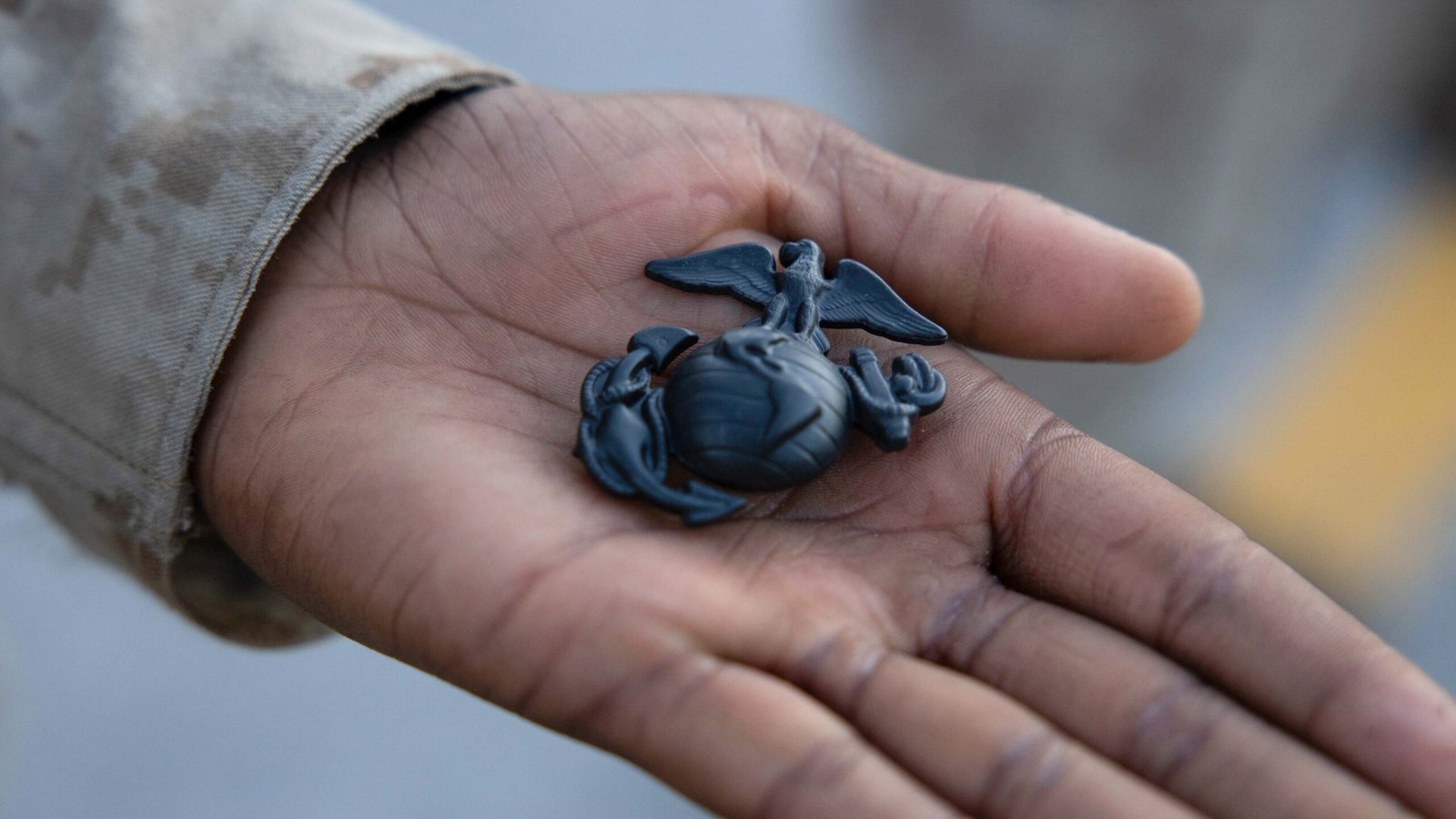Every Marine wears the same insignia: the iconic Eagle, Globe and Anchor. Though the symbol’s design has changed, its meaning has remained true, and generations of Marines point to earning theirs as a moment of pride and joy.
A central part of Marine Corps heritage, the EGA is made up of an Eagle, representing the United States, a globe to denote worldwide service, and an anchor to pay homage to the service’s naval roots.
However, its design has changed over the Marine Corps’ two-century history.
Earning the EGA is so deeply tied to the Corps’ cultural identity that enlisted recruits don’t receive theirs until the end of boot camp, It comes in a ceremony at the end of the Crucible, the culminating event in recruit training. As the exhausted but triumphant recruits gather on the parade deck, their drill instructors present them with the EGA.
That ceremony also marks the first time since arriving at Marine Corps Recruit Depot San Diego, California, or Parris Island, South Carolina, when they can call themselves Marines.
“When you’re getting the EGA for the first time, it definitely symbolizes becoming a Marine,” said Joe Ortiz, who served as a Reconnaissance Marine for 11 years before getting out of the Corps in 2023 as a staff sergeant. “But, for a lot of folks, I think it’s kind of the start of a new beginning. It can have its own meaning to them. It can be the greatest accomplishment in that person’s life up to that point, especially a very young person. So it’s a very emotional experience for a lot of people.”
Marine Corps photo by Lance Cpl. Blake Gonter.
From ‘fat turkey’ to ‘droop wing’ eagle — the EGA’s transformation
According to Owen Conner, the curatorial section chief for the National Museum of the Marine Corps in Triangle, Virginia, the origin of the EGA is complicated, with different versions of the device dating back to the years immediately after the service’s inception on Nov. 10, 1775.




Marines wore a device that displayed a fouled anchor in 1776. Conner said that changes were made over the following years but varied greatly due to officers having the freedom to visit jewelers to have the device made while enlisted Marines were issued whatever was available at the time.
While it may have been a more carefree time for Marines who didn’t have to contend with uniform regulations, it does make tracking the exact history and transformation of these early EGAs difficult.
“I don’t have images like a comprehensive guide to every one. It’s just there’s literally hundreds and hundreds of varieties,” Conner said.
Conner said that before an official uniform regulation was established, the early versions of the EGA had little to no guidance on wear, or design, and drew inspiration from the British Royal Marines.
“They style uniforms traditionally on what’s in the military fashion, and usually that follows who’s the dominant land or naval power of the time,” said Conner. “So the British always have the dominant sea power. So most uniforms from the American Navy or Marine Corps have British influence to them.”
Conner said in the early days, Marines had buttons with some sort of eagle or anchor heraldry. Still, it was common among other military branches, such as the Continental Army. But for the Marines, today’s EGA traces back to the different collar devices of each era.
“A lot of times, the variations come with the different types of eagles that are on them,” Conner said. “That’s how you can often identify eras with those.”
The eras of those earlier versions of the EGA can be identified by the type of eagle on the collar device. Early EGAs featured different designs that had nicknames, including the ‘fat turkey,’ ‘french bird,’ and the ‘droop wing eagle.’ For example, a World War I eagle “tends to look kind of like a fat turkey, but then other ones tend to be a more elegant eagle,” Conner said.
Subscribe to Task & Purpose today. Get the latest military news and culture in your inbox daily.
For decades, Marines would commonly wear the version they’d been issued when they joined or other previous designs, regardless of the current regs. In World War II, Marines were often seen wearing EGA designs that had been discontinued as far back as 1925.
“The droop wing eagle was only used for about 10 years, though they stuck around for longer. They came out in 1925, and Marines used those up until WWII — the old guys would still have them,” Conner said.
On June 22, 1954, Former President Dwight D. Eisenhower recognized the need to standardize the Marines’ official seal. Eisenhower signed into effect “Executive Order 10538 – Establishing a seal for the United States Marine Corps.” For the first time in 178 years, the EGA was standardized.
The modern-day Eagle, Globe and Anchor
Marines began wearing the final EGA in 1955, and that’s when today’s design for the EGA was locked in. The fouled anchor, paired with an eagle, over a globe is the hallmark symbol of the modern Marine Corps insignia. But, there is still variety.
Officers and enlisted also have different versions of the EGA, largely based on the materials it’s made of. Conner pointed out that officers’ insignias are made of gold or sterling silver but its globe is less geographically accurate. Meanwhile, an enlisted Marine’s EGA is one solid stamped brass device geographically accurate enough to identify Cuba.
“If you see Cuba on it, it’s an enlisted device,” Conner said. “If there’s no Cuba, then it’s an officer device.”
The device can vary depending on its part of the uniform. For example, the EGA on a Marine’s dress blue cover may vary in size compared to the other devices on the uniform.
But since 1955, the EGA has continued to hold to the same standard.

